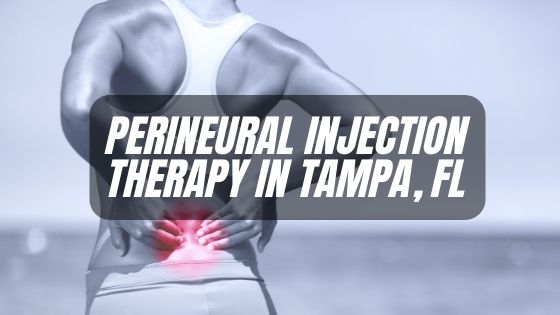Perineural Injection Therapy (also known as Neural Prolotherapy or Lyftogt Perinural Injection Treatment) is a simple and very effective treatment for pain. It uses injection of 5% dextrose (a natural sugar molecule) near cutaneous nerves that extinguishes neurogenic pain and neurogenic inflammation. Perineural injection therapy (also called neural prolotherapy or Lyftogt perineural injection therapy) helps calm pain and reduce neurogenic inflammation almost immediately.
The procedure is quick (takes 30 minutes in the office) and very safe as it uses an all natural solution of 5% dextrose.
Science has found some of the reasons for the profound effects of sugar or sugar alcohols in these near nerve injections that is satisfying, but there is still more to be researched at this time. Perineural Injections are so safe that it is worth a try in all pain conditions.
How effective are Perineural Injections?
After the first treatment pain relief may last for a period of 4 hours to 4 days. Repeated treatments (6-8 sessions) usually done weekly, result in a gradual reduction of the overall pain until maximal results are achieved.
According to Dr. Lyftogt, MD, 80% of all pain comes from our nerves. And in his clinical experience and the numerous studies he’s conducted for various painful conditions, perineural injections with 5% dextrose has an 80% effective rate. Meaning the nerves become damaged and send a pain signal and cause inflammation and treatment with perineural injections of 5% dextrose can help the vast majority of people with pain.
What is Neuropathic Pain?
The definition of neuropathic pain by Professor Douglas Zochodne states: “Neuropathic pain is a severe and debilitating pain that can render patients unable to walk, work, sleep or enjoy life…Full and effective regeneration of the peripheral nervous system usually extinguishes this pain.” (1) Dr. John Lyftogt, MD (pronounced “lift off”) of Christchurch, New Zealand has researched and developed the science of identifying and treating neuropathic pain and neurogenic inflammation with injections of 5% dextrose (D5W), or mannitol (M5W) near the damaged or inflamed nerves this extinguishes the pain and inflammation immediately and is diagnostic for neuropathic pain and neurogenic inflammation.
The History of Perineural Injections
John Lyftogt, MD, tells that he first tried dextrose on his own chronic pains from injury. He was so impressed with the relief that he told his wife and she volunteered her painful areas and had relief as well. After, many successful treatments he brought it into his practice.
One of the first patients was a long distance runner with debilitating Achilles tendonitis. In this case, Dr. Lyftogt treated the lateral sural nerve and lower saphenous nerve where they cross over the Achilles tendon with D5W. The patient was immediately out of pain. And had been unable to train for some time and since they felt better they, like any devoted athlete, promptly went out and ran a 10K. When Dr. Lyftogt discovered the patient had run the 10K, he was surprised and intrigued that the running did not cause a relapse of the tendonitis.
He recognized the treatment had therapeutic value beyond pain relief and he has since laid out the science and treatment of neuropathic pain. His patients were predominantly amateur and professional athletes with painful injuries, and with the treatment of their cutaneous nerves he found they got pain relief and could continue to train because the injury (the damaged nerve) was healed.
Dr. Lyftogt has learned that neurogenic inflammation can advance and worsen over time so the sooner the original injury is treated the fewer treatments are needed for complete healing.
How do perineural injections work?
The science of NPT developed by Dr. Lyftogt lays out the function and dysfunction of nerves when they are damaged. Neurogenic pain is caused by damage to the C-fibers of cutaneous nerves. C-fibers are unmyelinated nerves, about 1 micron in size, and are of low conduction velocity.
In other words they send a slow signal compared to other nerves. They were discovered in the 1960’s with the invention of the electron microscope which allowed them to be visualized. C-fiber nerves are afferent and efferent, which helps explain the complexity of experience of neurogenic pain.
There is a receptor on the nerves called TRPV-1 (transient receptor potential cation channel, subfamily V (vanilloid), member 1) whose previous name was the capsaicin receptor.
TRPV1 is regarded as the central nerve receptor in initiating and maintaining pain-related behavior in animals, and pain experience in humans (2). They are responsible for the burning sensation often described in pain syndromes (3). For a direct experience of the burning pain by a TRPV1 receptor and its treatment using the principles of NPT, eat a red hot chili pepper and then take a sip of a sugary drink and hold it in your mouth.
You will find that the burning sensation is extinguished because the sugar changes the signal from the TRPV1 receptors in the nerves of your mouth. This is proposed to be the effect that is happening with the injections of dextrose.
TRPV1 is the principle mediator of:
- Tissue maintenance and renewal
- Inflammation and neuropathic pain
- Pain with disease and degeneration
The TRPV1 receptors are activated by:
- Noxious stimuli
- High temperatures
- Pressure (greater than 30mm of Hg)
These stimuli cause the nerve to convey a pain/ inflammation message to the central nervous system.
It only takes pressure of 30mm Hg or greater to cause enough compression of the nerve to cause the pain. What happens is the cutaneous nerves passes through the fascia into the sub-cutaneous space from deeper tissue. As the nerve passes through openings these can be restive or the nerve can be swollen so the nerve is restricted. This causes compression of the nerve and the nerve compression and subsequent damage is called a chronic constriction injury (CCI) (4). Chronic constriction injuries can be palpated and occur by restriction of the fascia, or by entrapment in facial ligatures, or entrapment in scar tissue creating a scar neuroma. Exercise causes nerves to swell and can cause them to become entrapped in these restricted areas along the nerve either by adhesion or natural ligatures. There is a common even that happens when a swollen nerve is restricted by a fascial opening, the myelin sheath and nerve can be stripped with movement or stretching, causing an intusseption injury which is much like stripping the plastic cover off a wire. Very painful for the patient.
Nerve entrapments and Chronic Constriction Injury (CCI)
An example of this is there is a common chronic constriction injury (CCI) that results in low back pain. There is an osteo-fibrous tunnel, located 7-8 cm lateral from the midline of the spine on the posterior ilium. The affected nerve is the superior cluneal nerve and is from the L1, L2 or L3 nerve root. When a person bends forward the nerve stretches and should normally easily slide through the tunnel, but if the nerve is swollen it gets caught in the fascial opening and adhesion, CCI, causing stripping and bunching of the myelin sheath with nerve tissue. This is an intussusception injury of the nerve. The patient with this type of nerve injury reports that their back went out on them. They go for an exam and are usually diagnosed with a disc injury at L4-5 or L5-S1; a fairly common condition in people over 40 years old, that doesn’t usually cause pain. The patient is prescribed back rest and the nerve swelling recedes and the nerve remylinates and the pain goes away. Or they go for surgery and have some or no relief because the cause the nerve injury is not addressed by the surgery.
As the intusseption injury is repeated, the bunched-up nerve and sheath builds up on one or both sides of the tunnel and enlarges over time. Patients call these palpable lumps their “marbles”, “back mice” also they have had them diagnosed as lipomas with nerve infiltration. NPT is the ideal treatment for this type of low back pain. The injection of D5W to the osteo-fibrous tunnel entrances and along the nerve course immediately relieves pain and improves range of motion. The patient is amazed and frequently has a confused look on their face due to the sudden absence of pain with movements that used to always be excruciating. Dr. Lyftogt states the diagnostic criterion for neurogenic pain is if the pain goes away with treatment then it’s neurogenic in origin.
Neurogenic inflammatory signals and pain signals are sent by the release of Calcitonin gene-related peptide (CGRP) and Substance Pain (SP).
These are documented effects of CGRP from Susan Brain in 1985:
- Vasodilator of pre-capillary arterioles;
- Enhances the vascular permeability and protein extravasation effect of SP;
- Up-regulation of VEGF causing neo-vascularisation and neo-neurogenesis VEGF increases MMP1 leading to collagenolysis (degeneration of tendons);
- Increased tissue calcium levels (calcifications);
- Stimulation of osteoclasts (dystrophy bone, stress fractures).
The documented effects of Substance P include:
- Vasodilator of post-capillary venules which cause increased vascular permeability in post-capillary venules leading to protein extravasation (tissue oedema),
- Chemo-attractive to immune cells,
- SP in a positive feedback loop is an important regulator of the immune system. Activates immune cells to produce cytokines,
- Binds to mast-cells causing degranulation,
- Affects the amygdala causing depression,
- Stimulates CRH release in the hypothalamus up-regulating the HPA stress response. Prolonged activation may lead to exhaustion (DHEA depletion),
- Sensitizes peptidergic nociceptors, leading to neuropathic pain with allodynia and hyperalgesia.
- Impairs propriocepsis by delaying antagonist muscle reflex inhibition (neurogenic inflammation of MEP),
- Causes increased intramuscular compartment pressure.
It is interesting that the same TRPV1 receptors in the C-fibers also send a healing signal through the release of somatostatin and galanin, which are anti-inflammatory and reverse the effects of the CGRP and SP. This mechanism has not been studied as much as the devastating effects of CGRP and SP.
The TRPV 1 receptor is actively being researched to understand its properties and in a recent German study it was found that the TRP channel polymorphisms contributed significantly to somatosensory abnormalities of neuropathic pain patients. That the shape of the pore determines the neuropathic pain potential more than the TRPV1 itself. The pain patients in the study had a much higher frequency of the polymorphism than the healthy controls (5). It is hypothesized that 20-40% of the population of the USA have these polymorphisms which cause the slower healing response with the result being neurogenic pain and inflammation.
What to expect with Perineural Injections of 5% dextrose
- What a doctor and patient can expect after an perineural injection with 5% dextrose treatment is for 4 hours to 4 days to have complete relief of the pain.
- Then to have improvement of the pain each time the pain returns after the 4 hours to 4 days. Meaning is the pain is a 10 out of 10 then by the next treatment the expectation is that the pain will be an 8 or 9 out of 10.
- With single area pain syndromes I expect maximal resolution of pain after five to eight treatment sessions. There can be times during the treatment that the pain doesn’t follow the direct descent, that is not a sign of ineffectiveness of the treatment and usually after the next visit the descent of pain continues.
Perineural Injection therapy is easily the most important advancement in pain treatment and diagnosis in a long time. If you are living with a chronic nagging pain and looking for more than symptomatic relief from the use of over the counter medications like advil, aleve, tylenol and harsher medications like steroid injections or invasive procedures like nerve ablations, the Dr. Josh Hanson, DACM in Tampa, FL can likely help and provide some level of relief with perineural injections.
References:
1 Douglas Zochodne, A Definition of Neuropathic Pain, Calgary, Canada
Neurobiology of Peripheral Nerve regeneration, Cambridge University Press 2008, p4
2 Szolcsanyi J. “Capsaicin-sensitive sensory nerve terminals with local and systemic efferent functions: facts and scopes of an unorthodox neuroregulatory mechanism.” 1996. Chapter 20. Progress in Pain Research, Vol. 113. Kuwazawa T, Kruger L, Mizomura
3 Caterina MJ, Schumacher MA, Tominaga M, Rosen TA, Levine JD, Julius D., “The Capsaicin receptor: A heat-activated ion channel in the pain pathway.”
Nature 1997; 389:816-824
4 Mosconi, T Kruger, L. “Fixed-diameter polyethylene cuffs applied to the rat sciatic nerve induce a painful neuropathy: ultra-structural morphometric analysis of axonal alterations.” Pain. 1996; 64(1): 37-57.
4 Bennett GJ, Xie YK. “A Peripheral mononeuropathy in rat that produces disorders of pain sensation like those seen in man.”
Pain 1988; 33:87-107
5 Binder, Andreas, et al, “Transient Receptor Potential Channel Polymorphisms Are Associated with the Somatosensory Function in Neuropathic Pain Patients”. PLoS One, March 2011, Vol 6, Issue 3, e17387
American Neurologist Silas Weir Mitchell (1829-1914), Injuries of Nerves and Their Consequences (Philadelphia: J.B. Lippincott 1872)


